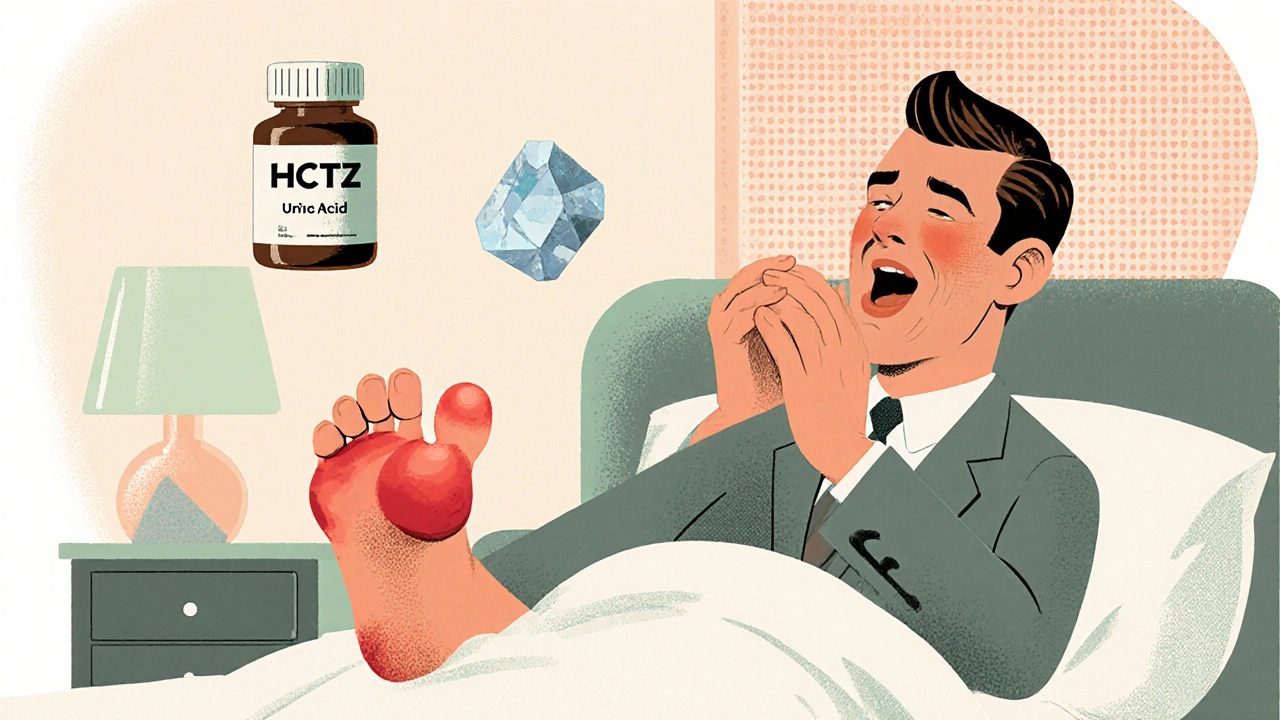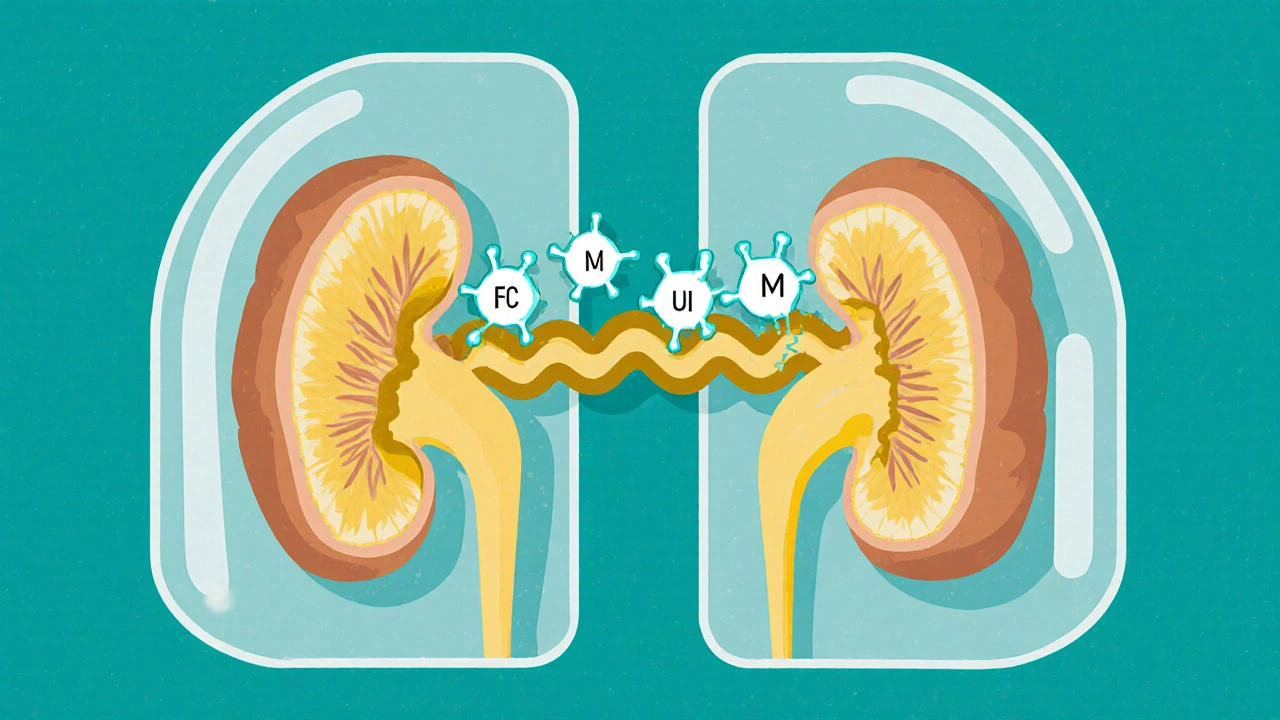Uric Acid Risk Calculator for Thiazide Diuretics
How This Tool Works
This calculator determines whether your current uric acid level puts you at risk for gout when taking thiazide diuretics. Based on clinical guidelines from the American College of Cardiology and European Society of Cardiology.
The risk thresholds are:
- Men: >7.0 mg/dL = High risk
- Women: >6.0 mg/dL = High risk
Risk Assessment
Enter your uric acid level to see your risk assessment.
Many people take thiazide diuretics like hydrochlorothiazide (HCTZ) to control high blood pressure. It’s cheap, effective, and has been used for over 60 years. But if you’ve ever had gout-or know someone who has-you might have heard a warning: thiazide diuretics can trigger painful flare-ups. This isn’t just an old wives’ tale. It’s backed by solid science, real patient data, and clinical guidelines. The connection isn’t subtle. It’s direct, measurable, and happens fast.
How Thiazide Diuretics Raise Uric Acid
Thiazide diuretics work by stopping your kidneys from reabsorbing too much sodium. That means more water and salt leave your body through urine. Lower blood volume = lower blood pressure. Simple. But here’s the catch: your kidneys use the same transport system to move sodium and uric acid. When thiazides step in, they compete with uric acid for space on a protein called OAT1. This is like two people trying to squeeze through the same door at once. Uric acid gets pushed back into your bloodstream instead of being flushed out.
Studies show this effect kicks in within 3 to 7 days of starting the drug. Your serum uric acid level can jump by 6% to 21% from baseline, depending on the dose. Higher doses? Bigger spikes. It doesn’t matter if you’re taking HCTZ or chlorthalidone-both do this. And it doesn’t go away after a few weeks. It sticks around as long as you’re on the medication.
Who’s at Risk for Gout?
Not everyone who takes thiazides gets gout. In fact, only about 1 to 2% of users develop full-blown gout. But that doesn’t mean it’s rare. With over 35 million prescriptions filled in the U.S. each year, even 1% adds up to hundreds of thousands of people. The real risk isn’t just the drug-it’s your body’s baseline.
If your uric acid was already above 7.0 mg/dL (for men) or 6.0 mg/dL (for women), you’re in the danger zone. That’s called hyperuricemia. It’s not gout yet, but it’s the soil where gout grows. Genetics play a role too. If your family has a history of gout, your risk goes up. So do other things: drinking beer, eating red meat or shellfish, being overweight, or having kidney problems.
One 2024 study tracked over 247,000 people without prior gout. Those who took thiazides for more than 180 days were 41% more likely to need an antigout medication than those who didn’t. That’s not a small increase. That’s a clear signal.
What Does Gout Actually Look Like?
Thiazide-induced gout doesn’t act any differently from gout caused by anything else. It hits hard and fast. The classic sign? Sudden, burning pain in the big toe joint. It’s often so bad that even a bedsheet feels like sandpaper. The joint swells, turns red, and gets hot to the touch. Most cases involve just one joint at first-usually the big toe, but sometimes the ankle, knee, or finger.
By the time someone goes to the doctor, their uric acid level is almost always above 6.8 mg/dL-the point where crystals start forming in the joint. And here’s the irony: many patients don’t even know their uric acid was rising. They’re just managing blood pressure, and then one morning, they can’t walk. That’s when they find out.

Is It Safe to Keep Taking Thiazides?
If you’ve never had gout and your uric acid is normal? Thiazides are still considered a safe first-choice option for high blood pressure. The American College of Cardiology and European Society of Cardiology both say so. The cardiovascular benefits-reducing stroke, heart attack, and heart failure risk-often outweigh the small chance of gout.
But if you’ve had gout before? That changes everything. Most guidelines now say: avoid thiazides as a first-line choice. If you’re already on them and you’ve had a flare, don’t stop cold turkey. Talk to your doctor. You might need to switch slowly. Stopping suddenly can cause rebound high blood pressure.
And here’s a key point: many doctors miss this. A 2022 study found that only 85% of patients with a history of gout had their uric acid checked before starting thiazides. That means 1 in 7 people were put on the drug without even knowing their risk.
What Are the Alternatives?
There are other blood pressure medications that don’t raise uric acid-and some even help lower it.
- Losartan: This is an ARB, a type of blood pressure pill that actually helps your kidneys get rid of uric acid. It’s not stronger than HCTZ at lowering BP, but it’s gentler on your joints. It’s also more expensive-about 25-30% more than generic thiazides.
- Calcium channel blockers: Like amlodipine. These don’t affect uric acid at all. They’re good for older adults and people with diabetes. They’re also widely available as generics now.
- Spironolactone: This is a potassium-sparing diuretic. Unlike thiazides, it doesn’t block uric acid excretion. In fact, it can help lower levels slightly. It’s often used in heart failure, but it’s also a solid option for people with gout and hypertension.
None of these are perfect. Losartan can cause dizziness. Spironolactone can raise potassium levels, especially in people with kidney disease. But they’re better choices than forcing a drug that’s known to trigger pain.

What Should You Do?
If you’re on thiazides and you’ve never had gout:
- Ask your doctor for a simple blood test to check your uric acid level. It’s cheap and quick.
- If it’s above 7.0 mg/dL (men) or 6.0 mg/dL (women), talk about lifestyle changes: cut back on alcohol, avoid organ meats and shellfish, drink more water, lose weight if needed.
If you’ve had gout before:
- Don’t panic, but do act. Ask your doctor: “Is this medication safe for me?”
- If you’re on a high dose of HCTZ (like 50 mg daily), ask if a lower dose or different drug might work.
- If you’re already taking allopurinol or colchicine for gout, your doctor might still keep you on thiazides-but only if your uric acid is kept below 6.0 mg/dL.
The bottom line: thiazide diuretics aren’t evil. They’ve saved lives. But they’re not neutral, either. They have a real, measurable effect on your body’s chemistry. And if you’re prone to gout, that effect can turn a routine pill into a trigger for months of pain.
Monitoring and Prevention
The best way to avoid problems? Know your numbers. Get your uric acid checked before starting thiazides. Then again after 3 months. If it climbs, you have options. You can adjust your diet, switch medications, or add a low-dose allopurinol (100 mg daily) to keep crystals from forming.
And don’t forget this: hypertension and gout often travel together. High blood pressure increases your risk of gout. High uric acid increases your risk of high blood pressure. It’s a loop. Treating one without thinking about the other can make the other worse.
There’s new research coming. A 2023 clinical trial is testing a new kind of diuretic that targets sodium without touching uric acid transporters. Results won’t be ready until late 2025. But until then, we have what we have. And that’s enough to make smarter choices.
Can thiazide diuretics cause gout even if I’ve never had it before?
Yes. While only 1-2% of people on thiazides develop gout, the risk is real. If you have high uric acid levels, a family history of gout, or other risk factors like obesity or kidney disease, your chance increases. The drug doesn’t cause gout out of nowhere-it pushes your body past a tipping point you may not have known you were close to.
How soon after starting thiazides does uric acid rise?
Uric acid levels can start rising within 3 to 7 days of starting the medication. The increase is usually noticeable by the end of the first week and continues to climb over the next few weeks. It doesn’t happen overnight, but it happens faster than most people expect.
Is chlorthalidone riskier than hydrochlorothiazide for gout?
No, not significantly. Early studies suggested chlorthalidone might be worse, but a 2019 direct comparison found both drugs carry nearly the same risk of triggering new-onset gout when given in similar doses. The difference isn’t in the drug-it’s in the dose and how long you take it.
Can I take allopurinol with thiazide diuretics?
Yes, and many doctors do exactly that. If you need thiazides for blood pressure and have a history of gout, starting allopurinol at 100 mg daily is a common strategy. It doesn’t cancel out the uric acid rise, but it keeps levels low enough to prevent crystals from forming. This approach is recommended by the European League Against Rheumatism.
Will stopping thiazides lower my uric acid?
Yes. Once you stop taking thiazide diuretics, uric acid levels typically return to baseline within 2 to 3 months. But don’t stop on your own. High blood pressure can rebound, and sudden changes can be dangerous. Always work with your doctor to switch safely.
Are there any foods I should avoid if I’m on thiazides?
Yes. To reduce your gout risk, limit alcohol-especially beer and liquor-since it blocks uric acid removal. Avoid organ meats (liver, kidney), shellfish like shrimp and mussels, and sugary drinks with high-fructose corn syrup. Drink plenty of water to help your kidneys flush out uric acid. These steps won’t eliminate the risk, but they can help.


Write a comment